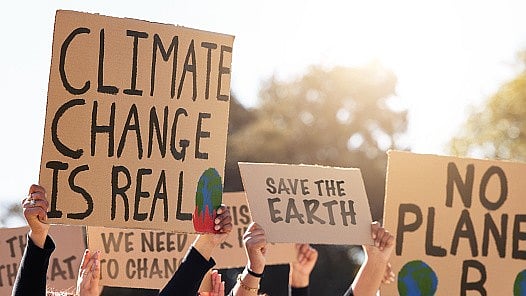
Representative image of climate change protest.
Credit: iStock Photo
With just one more week to go for the global conference on climate in Dubai—CoP-28 (Conference of Parties 28)—where all Heads of States will discuss global climate change, the news emerging from the United Nations is disturbing.
Earth has sped up to 2.5–2.9 degrees Celsius of global/anthropogenic warming since pre-industrial times and is set to blow well past the agreed-upon international climate threshold, a UN report has indicated.
To have a thin possibility of keeping warming to 1.5 degrees Celsius, limited by the 2018 Paris Climate Agreement, countries will have to slash their emissions by 42% by the end of this decade, said the United Nations Environment Programme’s Emissions Gap report issued early this week. The report added that carbon emissions from burning coal, oil and gas rose by 1.2% in 2023.
The unfolding apocalypse
This year, Planet Earth got a taste of what is in store, setting the agenda for the Dubai meet. But, where the Dubai meet will take the world, or, more pertinently, humanity is anybody’s guess, if one critically examines how things unfold.
Significantly, the climate meeting has been scheduled to occur in oil-rich Dubai. The CoP President, Sultan Al Jaber, heads one of the world’s largest oil companies, Abu Dhabi National Oil Company. The president will likely be less inclined to push the world away from fossil fuels.
By the end of September 2023, the daily global average temperature exceeded 1.5 degrees Celsius, the limit set earlier, above mid-19th century levels, on 86 days. That increased to 127 days because nearly all of the first two weeks of November and all of October reached or exceeded the 1.5-degree Celsius limit, according to the European climate service, Copernicus.
This is 40% of the days so far this year. On November 24, the Earth hit 2 degrees Celsius above pre-industrial levels for the first time in recorded history, according to Copernicus Deputy Director Samantha Burgess.
“It’s an indication that we are already seeing a change, a rapid acceleration,” said Anne Olhoff, lead author of the report. “Based on what science tells us, this is just like a whisper. What will be in the future will be more like a roar,” she added.
Alarming Countdown
“Broken Record” is the title of the latest United Nations Report on climate, a clever pun. It suggests that all previous warnings of the consequences of rising greenhouse gas emissions are being ignored and that new ceilings are being breached.
The annual emission report, usually timed close to the climate debate, reiterates in sharper language that progress since the 2015 Paris Agreement has been tardy. The goal was to keep the temperatures from rising over 2 degrees Celsius and, “as far as possible, below 1.5 degrees Celsius” of pre-industrial levels.
However, things turned out to be very different due to the intransigent attitude of the West or, more particularly, the duplicity of emission control. Notably, the world emitted 57.4 billion tonnes of carbon in 2022, an increase of 1.2% over what was emitted in 2021.
In terms of solutions, the UN report repeats sage advice it has offered for years: the wealthiest countries and those historically responsible for gobbling up sparse space of atmospheric capacity for carbon storage must commit to greater and faster reductions. While legalese and nit-picking have been characteristic of climate summits, little time is left for the world to get its act together.
What must India do?
An aberrant climate will hurt Indians, from the individual to the national level. Climate change could start changing brain structure and worsen our mental health and cognition, which has been reported very recently by the science journal Nature.
Climate change affects health directly, causing more sickness and death. In more indirect ways, it affects nutrition, reduces working hours, and increases climate–induced stress.
A critical impact would be on India’s food security. If India has to adequately meet its internal food demand, the total food production needs to be raised by 60% from the current level by the year 2050.
In India, crop yield decline due to climate change between 2010 and 2039 could be as high as 9%. With the current field/crop production practices in place, this would be impossible to bridge. India must switch to “Climate Smart Agriculture” (CSA).
CSA comprises three objectives: 1) sustainable increase in agricultural productivity and incomes; 2) adapt and build resilience to climate change; and 3) reduce greenhouse gas (GHG) emissions.
It is important to note that the third has been largely contributed by the highly chemical-centric, soil extractive farming euphemistically known as the ‘green revolution’.
Though there are many routes, two methods which stand out are: 1) to tap the potential of “crop wild relatives” of many cultivated crops like wheat, rice and millets, which have remarkable capabilities to withstand abiotic stress like climate change; 2) a significant shift in our soil management techniques, especially concerning fertiliser application.
(The author is a former professor, National Science Foundation, The Royal Society, Belgium)